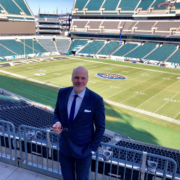Behind the quest to find and treat rare diseases
As Chief Scientific Officer at Ionis Pharmaceuticals, Dr. Frank Bennett sets strategic research directions for the Carlsbad, California-based company, which specializes in RNA-targeting therapeutics. Dr. Bennett has worked at Ionis for 35 years, and, in that time, he has worked to bring several drug treatments to fruition. Perhaps the most famous of these drugs is Spinraza, which is used to treat a rare neuromuscular disorder called Spinal Muscular Atrophy (SMA). Recently, Dr. Bennett has been involved in developing a drug discovery program that focuses on new approaches or technologies to make medicines. BrainWise Managing Editor Matt Villano recently sat down with Dr. Bennett to talk about his career finding and treating rare diseases, his work on Spinraza, and what sort of treatment innovations might come next. What follows is an edited transcript of their chat.
BrainWise: What does Ionis do as a company?
Dr. Frank Bennett: We’ve been focused on RNA-targeting therapeutics for the last 35 years. We were founded in 1989, in Carlsbad, and the focus of the company at the time was to use a type of genetic medicine called antisense oligonucleotides to modulate the amount of a protein product that’s being produced. These antisense oligonucleotides are short strings of chemical synthesized nucleic acids. We make them on a machine, and they are designed to bind to RNA through the same mechanism that DNA binds to itself. Binding to specific RNAs can prevent certain proteins from being made. In some cases, you can increase the amount of protein that’s being made if it’s deficient. There are many genetic diseases where you have a loss of protein, and we’re using our technology to recover that function. By targeting RNA. antisense oligonucleotides work upstream from more traditional drugs, which tend to bind proteins.
In the beginning, we really didn’t know much about the technology, and so we did a shotgun approach where we looked at a variety of different target organs in the body, trying to figure out where the technology would work well and where it wouldn’t. It took us 10 years to do the basic research and figure out where antisense drugs work best. Surprisingly, it turns out that the brain is one organ where they work quite well. We found that our drugs don’t cross the blood-brain barrier, but if you inject the drugs into the fluid that surrounds the brain—the cerebral spinal fluid—you get very broad distribution, so that’s how we approach it. You do that through a spinal tap.
BrainWise: How are you using this technology to discover and treat rare diseases?
Dr. Bennett: Our interest in rare neurological diseases is that these diseases oftentimes have a genetic basis. That means there’s a defective gene causing the disease. We can use our technology to address that genetic defect. If you’re making too much of a protein that’s toxic, we can decrease the amount of that toxic protein that is made. In some cases, where you’re not making enough of a protein, we have a way of using our technology to increase the production of a protein. We can go both directions—we can increase or decrease the amount of protein. We’re looking for genetic diseases where we know what’s causing the disease, and where there has been enough research on that gene to understand mechanistically why that gene mutation is causing the disease. Then we can apply our technology to address the defect.
BrainWise: How does Ionis prioritize which rare diseases to target for drug development?
Dr. Bennett: [We ask:] Is there a strategy that we can use our technology to address the genetic basis of the disease? Is the genetic disease caused by a toxic protein that’s being produced? If so, we can use our technology to decrease the amount of that toxic protein that’s being produced. So that’s first and foremost. Then we look at the unmet need. Are there a lot of drugs out there already for this disease or are there no drugs? We tend to focus on diseases that don’t have drugs that are available, where there is a high medical need. The severity of the disease also is important. Is it life-threatening where the disease causes a shortening of lifespan or high impact on the quality of life? Our goal is not just to treat symptoms, but really to have an impact on the underlying basis for the disease.
BrainWise: What are some of the challenges associated with researching and developing medications for some of these rare diseases?
Dr. Bennett: Because these diseases are rare, they are understudied. That’s really one of the biggest challenges. What is the natural history of the disease? What’s the heterogeneity in the patient population? We need to know [these things] to be able to design a proper clinical study. Do we need to treat for three months, or do we need to treat for two years to see an effect? We ask those kinds of questions. We also ask: How variable is the disease? That’s going to set the size of the study. If it’s highly variable, we’re going to need more patients. If it’s very tight in the disease progression, then we need fewer patients.
We also pay attention to biomarkers. Oftentimes, we develop these biomarkers in our laboratory before we start clinical studies. It’s important to de-risk a program, so that we use biomarkers two ways. One way to use biomarkers is to show that our drug is doing what it was designed to do. If we engage the target but there’s no clinical benefit, that tells us we probably are approaching it the wrong way. If we don’t engage the target, then that means that our drug just didn’t do what it was designed to do. The worst thing at the end of the study is to not know why the drug doesn’t work. We [also] ask: Are there biomarkers that can be used to measure disease progression or improvement in their disease?
BrainWise: How important is collaboration with other research organizations and patient advocacy groups in these efforts?
Dr. Bennett: Collaborations have been critical for our success in our ability to treat these diseases. SMA, for instance, is a disease due to a deficiency of a protein called Survival Motor Neuron, or SMN. We have a strategy that we developed with our collaborators at Cold Spring Harbor Laboratory [in Cold Spring Harbor, New York], where we used our technology to increase the amount of SMN protein and recover the function that was missing in these patients.
Because these are rare diseases, oftentimes there’s only a few individuals in the world that are studying these diseases. These experts know the details of the disease, either clinically or from a basic research perspective. For us to go up that learning curve and be able to understand all the nuances on our own would take us several years. So we really leverage the experts to help us. We’re the experts in the technology and the drugs, but they’re the experts in the disease. Later, as we start getting toward the clinical part of a project, it’s important to start engaging the clinicians who are taking care of the patients so that we understand some of the issues. It’s important to measure the right thing that’s occurring in patients so we can demonstrate that the drug is benefiting or hurting the patient.
Finally, patient organizations are also critical. Often, they put us in touch with patients. We need to know what’s important for the patients or their families, so that we can gauge whether we’re on the right track and whether we have the right measures in place. We also use patient organizations to help communicate the status of the program to their members.
BrainWise: How do you balance that need for scientific rigor with the urgency of providing treatments for patients with rare diseases who may not have that long to live?
Dr. Bennett: It’s important that we develop safe and effective drugs, and so that’s really our focus. Unfortunately, that means that some patients today may not get access to therapy in time. I find that personally very frustrating, but it’s better to do that than to put something that could cause toxicity in a patient and hurt them. There are always going to be patients that won’t get access to a drug because their disease has progressed so rapidly that they miss out on an early clinical trial. Ultimately, we focus on getting the drug approved so we can help all patients. It’s heartbreaking sometimes to communicate with families where a patient isn’t eligible to participate in a study. I’ve had a lot of phone calls trying to explain that to a family and it’s very hard.
BrainWise: To what extent do some of the treatments you’ve devised impact cognition, and how do you assess that over the course of a treatment program?
Dr. Bennett: A lot of the diseases we work on have associated cognitive impairment. If it’s an important component to the disease, we try to have specific measures that are really designed to measure cognition. Depending on the disease, it could be a very highly ranked endpoint. With [some] diseases it’s more [of an] exploratory or secondary endpoint. For some of our pediatric neurological diseases where there are cognition deficits—Angelman syndrome is one example—[cognition] is an important endpoint we’re looking at. For something like Huntington’s disease, it’s part of a composite index that measures cognition and motor function along with behavior. There are some diseases we work on where there’s very little cognitive impairment, and we are doing just a general neurological exam.
BrainWise: To what extent did the success of Spinraza change the way you think about drug development?
Dr. Bennett: SMA is a pediatric neurological and neuromuscular disease in which motor neurons start dying off and patients become paralyzed. You can think of it as a pediatric form of ALS. In its most severe form, infants start developing symptoms within a few weeks to a couple months of life, and they never gain the ability to sit. They often die of their disease within the first year to 18 months because they’ve lost control of their respiratory muscles. Unfortunately, those most severe patients account for about 50 percent of the people with the disease.
Spinraza was developed to help [patients with this disease]. When we started the study, we were expecting to stabilize the disease. We would have been happy with that, because [SMA is] progressive. Surprisingly, [as we administered Spinraza], we saw symptoms improve. Pediatric patients started gaining function they had never seen before, and older patients regained function they had lost. Then our partners at Biogen did a pre-symptomatic study. They discovered that if you start treating infant patients before they develop any symptoms, they start developing normally. Essentially, [this] changed the disease for these patients.
[These outcomes aren’t] unexpected for a disease where you’re losing neurons, but Spinraza was really the first time it was demonstrated that prophylactic treatment can prevent a disease from occurring [in the first place]. It’s been a remarkable drug. And personally, it’s one of my life journeys that I’m very honored to have been part of. With the approval of Spinraza, there are now probably 70 companies in the world that are developing technology for treating a variety of neurological diseases, and it was really based on Spinraza and the very remarkable efficacy that we saw in that disease.
BrainWise: What’s next for Ionis?
Dr. Bennett: We will continue to use antisense technology to create better and better drugs for patients. I mentioned earlier that our drug is given by intrathecal dosing—a spinal tap. One of things we’re doing now is creating drugs that have longer duration of effect. We have drugs that look like they could support once-every-nine-months or once-a-year dosing, instead of once every month. This means patients come in and see their doctor less frequently, which would be more convenient for the patients and treating physicians. We are also working on technology [we can deliver via] peripheral injection—through a subcutaneous injection or maybe an IV—where we [can] get the drug across the blood-brain barrier and start treating systemic diseases. That’s going to be even more convenient for patients; every three to six months they’ll come in for a shot and go home and live their life normally.
One of the other things we’re working on is a form of genetic medicine called gene editing that has the potential to effectively cure a disease for patients; they would get a one-time treatment and never have to worry about the disease again. I don’t like to use the word ‘cure,’ but the goal is to develop long-term treatments that make the patient’s lives much better. We’re not there yet, but I think in the next five or 10 years that’s going to be feasible to think about. Rare diseases are driving innovations in new technology. I see it just getting better and better for patients going forward.
This article has been factchecked. For more about that process, click here.









